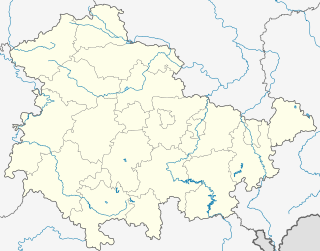Dobritz caves
| Dobritz caves
|
||
|---|---|---|
|
Cave entrance |
||
| Location: | about 1 km south of Döbritz | |
| Height : | 320 m | |
|
Geographic location: |
50 ° 41 '16.8 " N , 11 ° 38' 26.2" E | |
|
|
||
| Particularities: | Ground monument | |
The Döbritz caves are located in the Gamsental, south of Döbritz , in the Saale-Orla district in Thuringia . The Döbritzer Switzerland called Zechsteinmassiv has a series of rock fractures and three caves on.
Desert scour
At the southern end of the valley is the cave popularly known as the "Desert Scheuer" with a wall-like structure in front of it. The excavation carried out at the end of the 19th century was particularly focused on the wall. In 1925/26 a cave was excavated with the aim of recovering paleolithic material. The finds made were lost during the Second World War , so that the use cannot be reconstructed.
Knee grotto

In 1930, the lay researcher M. Richter discovered a cave that he called the knee grotto and excavated with numerous helpers over the next eight years. A lot of flint tools and bones came to light in the lower layers . The finds allow the classification in the Magdalenian . Their distribution shows that the people mainly stayed in front of the cave. The multi-layer plate bed in front of the cave made of foreign rock can be assigned to the primary find layer that formed at the end of the Vistula glaciation during an interstadial . Among the finds in and in front of the grotto are remarkable small art. Under the pavement there was a piece of reindeer antler rod perforated lengthways with engraved heads of the musk ox and ibex as well as rows of dots and arcs, an ornate harpoon tip and a stylized ivory foot.
Urd cave
Further Upper Palaeolithic art comes from the Urd cave, 100 m to the north, discovered by M. Richter in 1937. During the excavation between 1946 and 1959, a bear's head was found, which was carved from the skull of a reindeer using the natural shape. The Ice Age Homo sapiens is only a little more robust, as a skull from the Urd cave shows, where the base is missing. Manipulation of skulls is also known from ethnology. In funeral rites, the base of the skull is removed so that the brain can be removed. It can be assumed that this skull also got into the cave in connection with cultic acts. This is supported by the location in an inaccessible part. Other human bones and stone tools were found in the vicinity .
The finds show that the Döbritz caves have been visited intermittently since the Gravettian era. The spectrum of forms of the Magdalenian shows connections to Moravia, Switzerland and Western Europe.
Web links
literature
- R. Feustel et al .: The Urd Cave near Döbritz. In: Alt-Thueringen, 11 1971
- R. Feustel: The knee grotto. A Magdalenien station in Thuringia. Weimar 1974
Individual proof
- ↑ S.Dušek: Prehistory and Early History of Thuringia p.42


